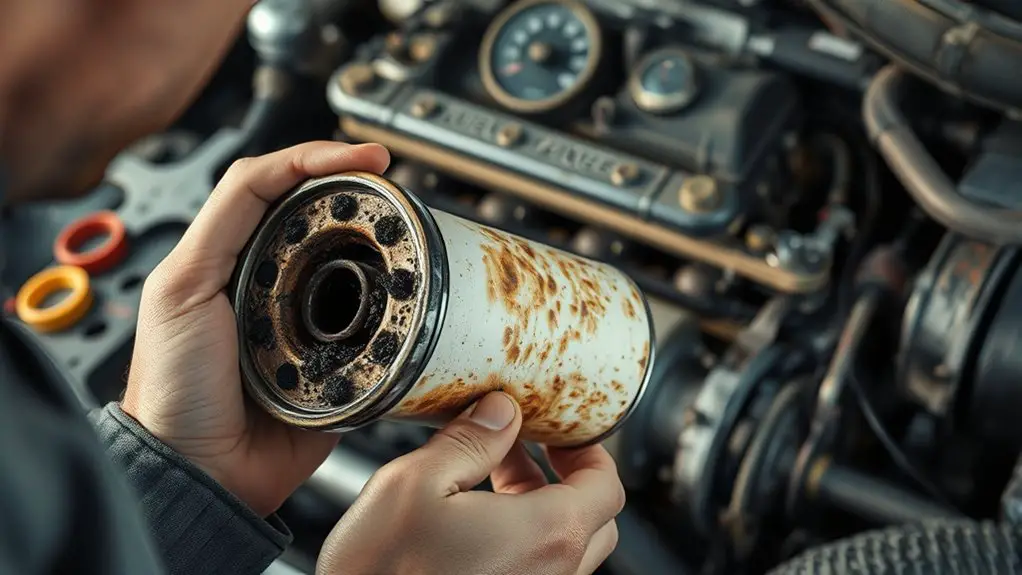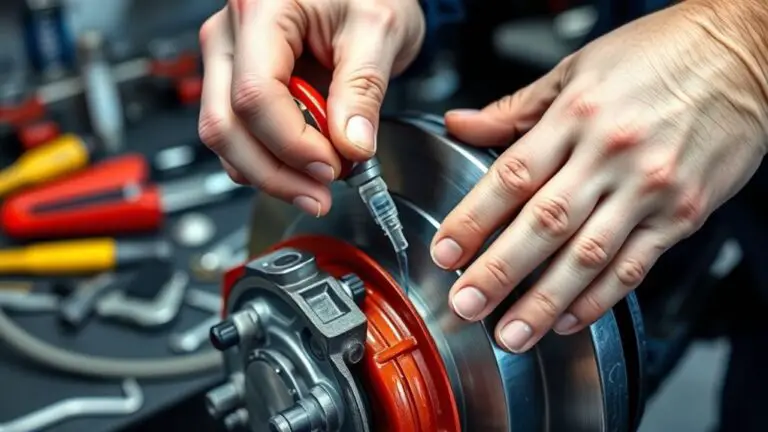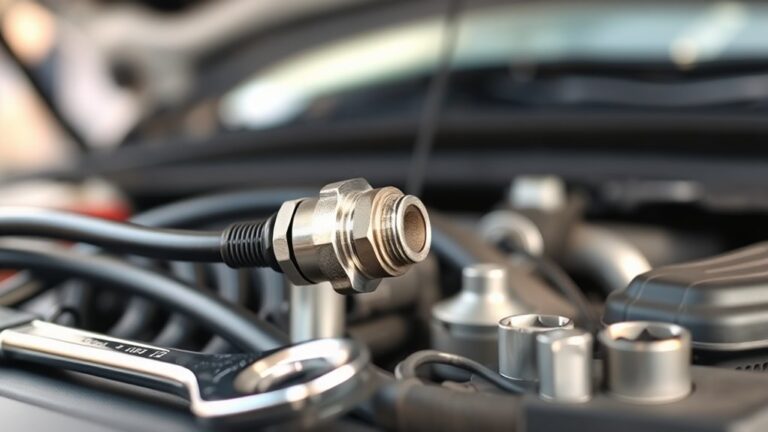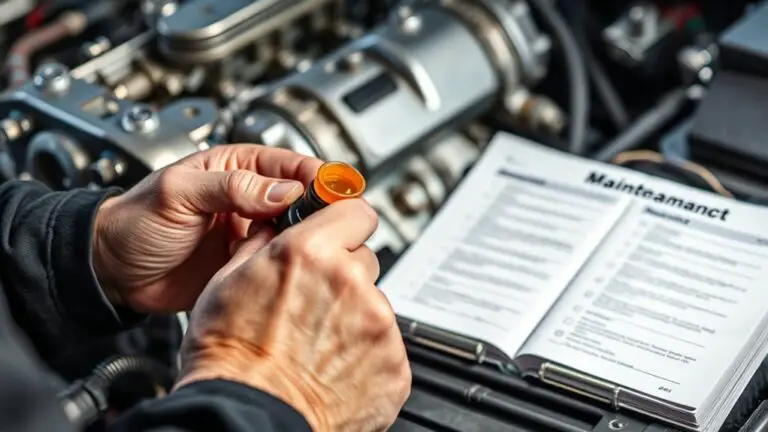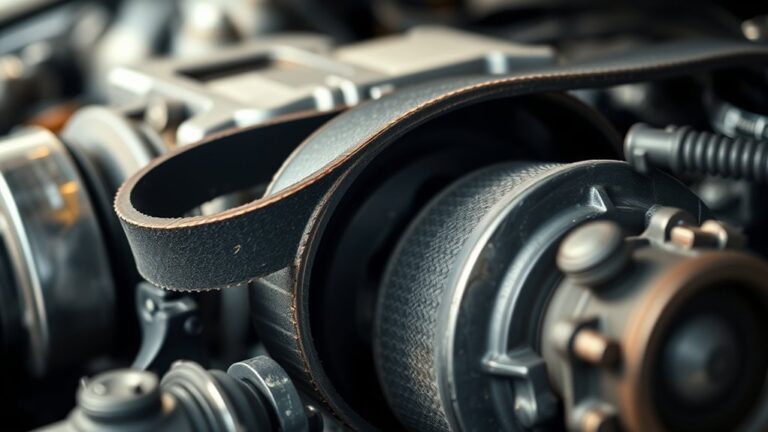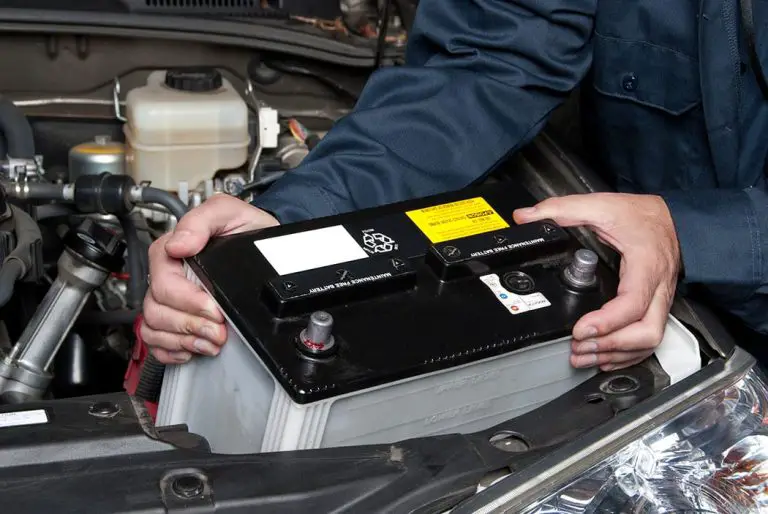How Contaminated Fuel Causes Low Fuel Pressure and Recovery Options
Contaminated fuel disrupts your fuel system by changing density, lubrication, and flow, which can lower pressure and trigger hard starts, stalling, or reduced power. Debris and water foul filters, clog injectors, and wear pumps seals, causing pressure spikes or drops. Particulates shift flow paths and raise differential pressure, shortening filter life and triggering bypass. Recovery involves isolating affected components, flushing, replacing filters, and testing pump performance. If issues persist, seek professional help for a thorough recovery plan and safeguards. You’ll learn more next.
Contaminants and Fuel System Impact
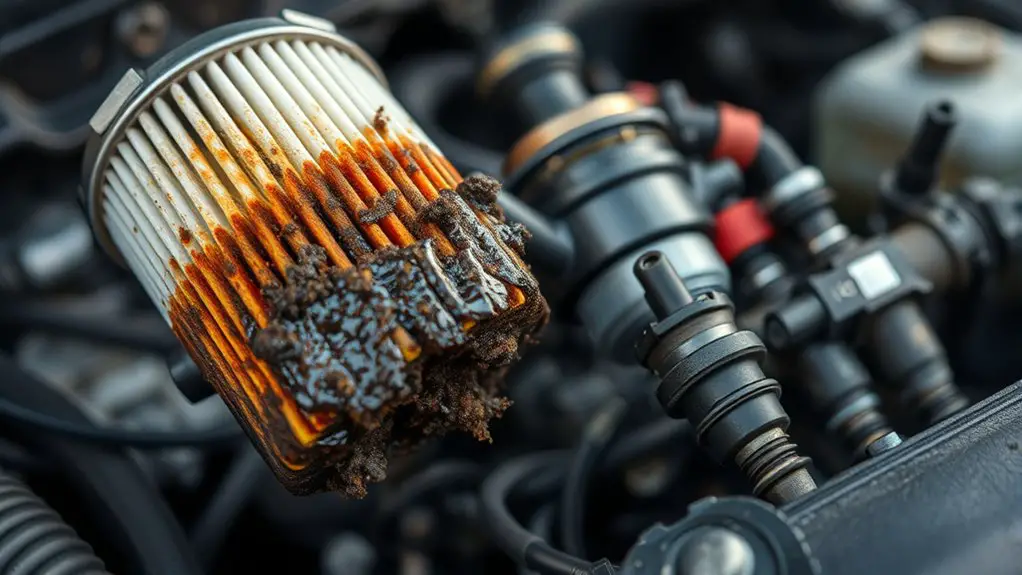
Contaminants in fuel can alter chemical properties and disrupt engine performance, leading to reduced efficiency and potential damage. You’ll notice shifts in combustion timing, injector spray patterns, and fuel atomization as particulate matter, water, or additives change viscosity and energy content. These changes stress seals, gaskets, and fuel rails, increasing leak risk and accelerating wear in pumps. Inadequate fuel quality disrupts filtration, elevating debris load that can clog filters and restrict flow, compounding pressure losses across the system. System maintenance becomes critical: regular filter changes, pump checks, and rail inspections help preserve steady pressure and prevent downstream faults. Contaminants also promote varnish formation and corrosion in metering components, skewing delivery accuracy and fuel-air mix. You should implement a proactive maintenance plan, run quality fuels, and verify contaminant levels during service intervals. Understanding these impacts enables you to target corrective actions, maintain optimum system performance, and minimize reliability concerns without compromising freedom of operation.
How Water in Fuel Affects Pressure
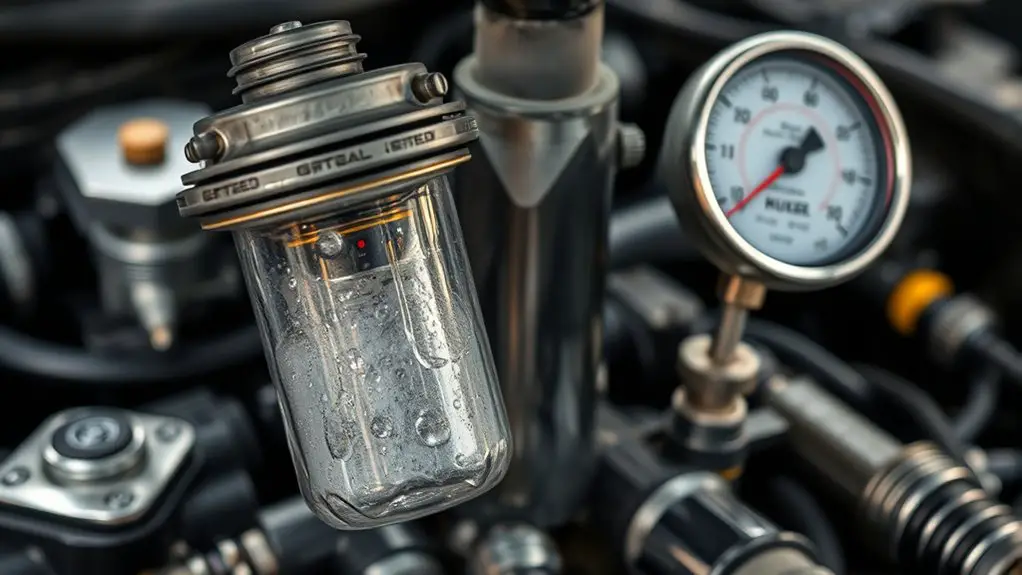
Water in fuel directly influences system pressure by altering density, lubrication, and the effectiveness of filtration and pumps. When water is present, density shifts, causing miscalculations in flow and pressure readings. You’ll notice reduced lubrication at high-shear interfaces, increasing wear on injectors, pumps, and valves. Water’s incompressible nature also disrupts pump head, creating transient pressure spikes or drops as the system fights aeration and cavitation. In the filtration stage, water contaminates media efficiency, shortening replacement intervals and permitting colloidal movement that bypasses filters under load. You should measure water contamination with calibrated tests and track pressure trends against baseline curves to identify anomalies early. Water presence degrades fuel performance by causing erratic delivery, incomplete combustion, and elevated exhaust temperatures, which undermine efficiency tests and operating margins. Maintain separation stages, seal integrity, and drainage practices to minimize water ingress, sustain stable pressure, and preserve reliability during recovery operations.
Particulates, Additives, and Filter Clogging
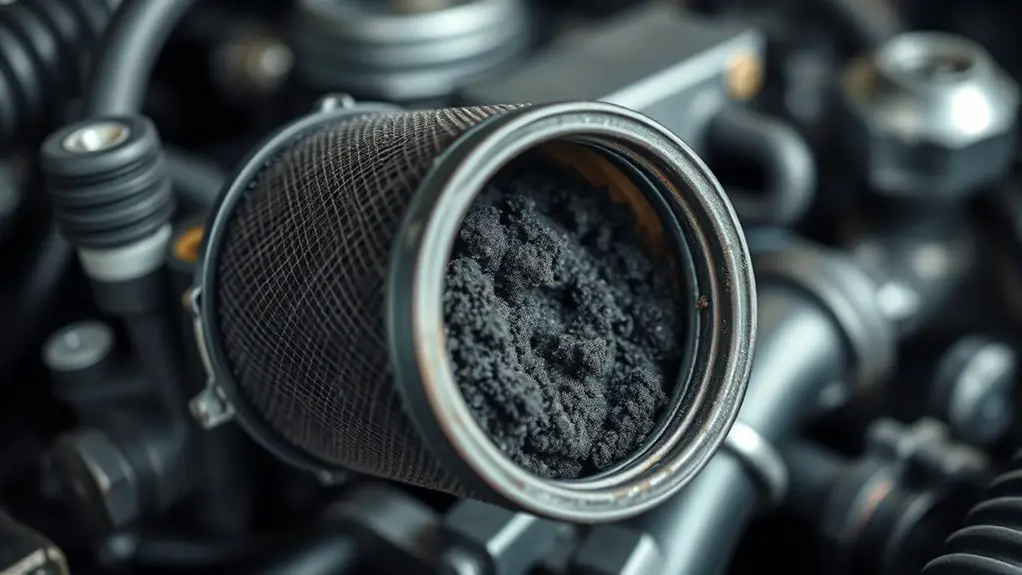
Particles, additives, and filter clogging critically affect fuel system reliability by altering flow characteristics and filtration efficiency; if particulates bypass or accumulate in the media, pressure drop rises and injector timing becomes inconsistent. You must monitor how contaminants interact with filtration media, as clogging shifts flow paths and elevates differential pressure across filters. Focus on maintaining predictable delivery by aligning fuel filtration performance with engine demands and fuel quality.
- Understand how particulates and additives change filtration resistance and why maintenance practices must track differential pressure.
- Implement defined replacement intervals and filtration media compatibility checks to prevent sudden flow restrictions.
- Schedule routine system cleanups and filter integrity tests to minimize deposit buildup and preserve injector timing accuracy.
Maintenance practices should be documented, data-driven, and repeatable, ensuring fuel cleanliness targets are met without over-maintaining. Precision in filtration assessment supports reliable fuel supply, reduces risk of sudden pressure drops, and sustains performance freedom while protecting components.
Diagnosing Low Fuel Pressure Symptoms
Diagnosing low fuel pressure begins with a structured assessment of symptoms and their likely causes. You’ll use a precise, methodical approach to separate fuel system issues from sensor or electrical faults. Begin with symptom correlation: sustained hard starting, misfires, or stalling under load point to pressure loss, while occasional hesitation may indicate injector or timing concerns. Next, employ diagnostic tools to quantify pressure and flow, noting pressures at key RPMs and across load ranges. Compare readings to manufacturer specifications and historical baselines. Inspect fuel supply for contamination, leaks, and foreign particulates that may degrade pressure. Validate wiring, grounds, and sensor signals that influence regulator behavior and pump control. Document all findings to build a traceable fault hypothesis. Use a systematic elimination to confirm fault location before proceeding with any remedy.
| Symptom/Observation | Diagnostic Action |
|---|---|
| — | — |
| Hard starting | Measure fuel pressure, verify pump operation |
| Stalling under load | Inspect regulator, test flow capacity |
| Misfires | Check injector timing and sensor signals |
| Inconsistent pressure | Verify wiring and ground integrity |
Recovery Steps and When to Seek Help
If contamination or low pressure is confirmed, start with immediate safety and containment steps, then prioritize systematic recovery actions. You’ll follow a disciplined sequence to restore reliability without guesswork, using defined recovery methods and documenting each stage for traceability. First, isolate affected components and prevent cross-contamination. Then assess fuel-system integrity, filter condition, and pump performance, noting readings and alarms. Next, implement controlled flushing, replace compromised filters, and use approved clean fuel sources. Finally, re-check pressure, purge air, and perform a staged pressure test to verify stability before return-to-operation.
- recovery methods: flushing, filtration, and component replacement guided by OEM specifications
- monitor and document: pressures, temperatures, and flow rates during each step
- seek professional assistance if anomalies persist or if warranty, safety, or emissions concerns arise
If you encounter persistent symptoms or uncertainties, pursue professional assistance promptly to guarantee safe, compliant restoration.
Frequently Asked Questions
Can Specific Contaminants Cause Intermittent Low Pressure Patterns?
Yes, certain contaminants can cause intermittent low pressure patterns. Contaminants like sediment, water, or varnish can intermittently clog the fuel filter, creating fluctuating flow and pressure drops. You should inspect fuel filter and track contamination sources, since recurring issues often point to contamination sources upstream. If patterns emerge, perform a systematic check of fuel lines, pump, and rail. Purge briefly, replace filter, and verify consistent pressure under load to confirm resolve.
Do Fuel Brands Differ in Contamination Risk for Pressure Loss?
Like a tightrope walker crossing a fogged river, you’ll find some brands pose higher contamination risk than others. Do fuel brands differ in contamination risk for pressure loss? Yes, they can. You should evaluate fuel quality and brand reputation when diagnosing fuel-system symptoms. In practice, monitor filtration, rail pressure, and injector cleanliness, and prefer brands with stringent quality controls to minimize contaminants that depress fuel pressure. Maintain records to support containment and recovery decisions.
Can Fuel Contamination Affect Turbocharged Engines Differently?
Yes, fuel contamination can affect turbocharged engines differently. You’ll see disrupted turbocharger performance, delayed spool, and intermittent boost due to contaminated fuel jets and injector inefficiencies. Your fuel filtration systems must trap contaminants before reaching the high-pressure pump. Expect increased turbine timing sensitivity and possible knock under boost. Maintain rigorous filtration, monitor fuel pressure drop, and guarantee clean rail delivery to protect turbocharger performance and overall efficiency. Regular diagnostics help prevent turbo-related failures.
Is There a Cost Range for Professional Fuel System Cleanup?
Like a tightrope wobbles under a gust, yes—cleanup costs for a professional fuel system typically range from $200 to $2,000 depending on contamination severity and needed components. You’ll need diagnostic labor, fuel filter replacements, additives, possible injector cleaning, and system verification. Get a precise quote outlining parts, labor, and any tank removal. You want certainty and freedom, so ask for a breakdown, include any warranty, and confirm test results after cleanup.
Can Ethanol Blends Influence Fuel Pressure Recovery Effectiveness?
Yes, ethanol blends can influence fuel pressure recovery effectiveness. Ethanol effects include altered volatility and lubricity, which affect pump head and injector calibration, while blend stability impacts phase separation and moisture handling in the fuel system. You’ll notice variations in recovery performance as ethanol content rises; tighter tolerances and proper fuel stabilizers help maintain consistent pressure. Monitor ethanol concentration, use compatible seals, and test fuel rail pressure after maintenance to guarantee reliable operation.

